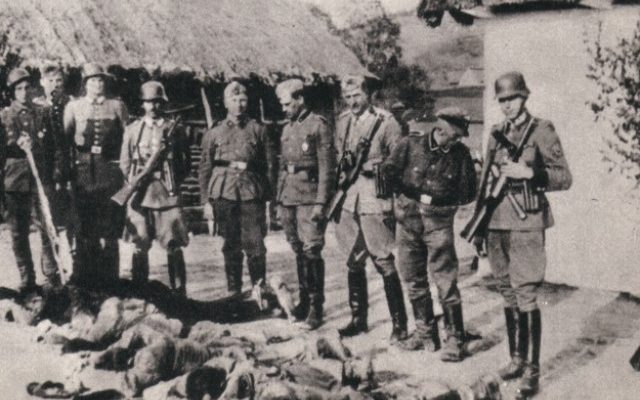In a late push for justice, Germany is investigating suspected members of the mobile “Einsatzgruppen” death squads.
Two suspected members of Adolf Hitler’s mobile “Einsatzgruppen” death squads identified by the Simon Wiesenthal Center (WSC) have been tracked down by German reporters but deny participating in wartime massacres.
The Einsatzgruppen were special units made up of SS and police personnel that followed behind the regular German army troops during the invasion of the Soviet Union in 1941, with the task of killing perceived racial or political enemies of the Nazi regime, mostly Jews.
The two suspects located by broadcaster ARD’s Politikmagazin Kontraste program, being aired Thursday night, both appear on Nazi-era roster lists of an SS unit that was attached to Einsatzgruppe C.
Einsatzgruppe C was responsible for one of the most notorious Holocaust massacres, the shooting of nearly 34,000 at Babi Yar, a ravine northwest of the Ukrainian city of Kiev, on Sept. 29-30, 1941.
The two elderly men were both on a list of 80 former Einsatzgruppen members provided in late 2014 by the Wiesenthal Center to German authorities with the expectation that they could still be alive.
‘Surprised’ to Hear About the Holocaust
One suspect, 94-year-old Kurt Gosdek, told Kontraste in an interview earlier this month at his home in northwestern Germany that, although he was part of the unit in Ukraine in 1941, he had worked behind the lines repairing vehicles. He claimed to know nothing of any massacres.
“When I was assigned to the workshop service it was relatively quiet, one had only one’s work,” he said. “Not the shooting.”
Following the Einsatzgruppen massacres, the Nazis established death camps and in total killed some 6 million Jews as well as others. Gosdek said he was “surprised” when he heard about the Holocaust after the war.
“It’s simply unbelievable that something like that happened,” he said.
Herbert Wahler, 95, confirmed that his name was on the Einsatzgruppen roster but refused other comment, according to transcripts of the interviews provided to The Associated Press.
“If you want to question me, then you’re out of luck,” he said at his home in central Germany. “I also have nothing to hide and from me you won’t hear anything.”
Jens Rommel, head of the special German prosecutors’ office in Ludwigsburg that investigates Nazi crimes, confirmed to the AP that the Justice Ministry had forwarded them the Wiesenthal Center list.
He said it had been narrowed down to eight people thought to be still alive, including the two featured in Kontraste’s report and one other from Einsatzgruppe C, but prosecutors had not yet gathered enough evidence to recommend charges.
“We need to at least confirm which time period someone was in a unit and which crimes committed by the unit they were part of,” he told the AP.
‘Everyone Who Assisted was Responsible’
Efraim Zuroff, the Wiesenthal Center’s head Nazi hunter, questioned how much more evidence was necessary. He said a new precedent in German law means that suspects who helped the Nazi machinery of genocide function — like death camp guards — can be prosecuted as accessories to murder even if it can’t be proved they killed anybody themselves.
“Everyone who assisted in any way shape or form was responsible,” he said in a telephone interview from Jerusalem. “Even if this guy was busy fixing cars, those cars took people to the sites to mass murder Jews … Bring these people to justice and put them on trial.”
Rommel said his office was moving “as quickly as possible” on the Einsatzgruppen, but has also been focusing limited resources on guards at seven concentration camps, including Buchenwald, Sachsenhausen and Bergen-Belsen, where it was easier to prove that suspects were on hand at the time of specific killings.
He said he expected to hand as many as 30 cases to state prosecutors by year’s end with recommendations that the suspects be charged, but cautioned that because of their ages, the number could rapidly change.
“Every year it’s more difficult because so many pass away,” he said.
By: AP





